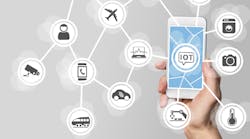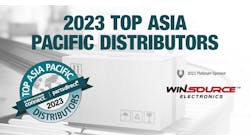Research firm Gartner Inc. has predicted that 8.4 billion connected "things" will be in use in 2017, with total spending on Internet of Things (IoT) endpoints and services reaching almost $2 trillion for the year.
But mustering the in-house technical expertise to support the design, development, and deployment of IoT solutions can be a challenge for OEMs. "Given the diversity of technologies, it can be difficult to find staff to support all IoT initiatives," the firm notes in its 2016 report Hype Cycle for the Internet of Things.
San Jose, Calif.-based WPG Americas is one of many companies looking to exploit that growing market opportunity. The 10-year-old subsidiary of Taiwan-based WPG Holdings—the world's third-largest electronics distributor, according to SourceESB—is a franchised partner for technology suppliers in the semiconductor, passive, electromechanical, interconnect, display, and lighting markets.
"The advantage that we have [over] OEMs is that we can see the breadth of technology that is available," says Len Wegner, director of IoT Solutions. He adds that the company's focus is on what he terms the "building blocks" of the edge devices within the IoT ecosystem.
"If you look at an edge device, no matter what fit, form, or function it has in the IOT space, there are three basic building blocks that each one needs," Wegner notes. "There's a need for sensors to capture data, for some type of control mechanism, and for connectivity."
WPG Americas also has the capability to provide a total IoT solution. If, for instance, a manufacturer requires design help, assistance connecting to the cloud, or hardware or software development, the company has the ability to align with third parties to help OEMs get to market quickly.
Wegner acknowledges that a number of the company's competitors in the U.S. market have more extensive line cards. But he says the deeper relationships that can be forged among a more limited supplier set can yield better customer solutions.
"Our competitors are formidable and have pretty much every supplier under the sun, which at 30,000 feet can be attractive," Wegner comments. "Ultimately, you need people to be able to sell that portfolio, and if they don't understand it because it's so overbearing and cumbersome, you turn into more of an order taker than a distributor with the ability to consult with their customers and determine the right technology for their solution."
Consumer IoT Applications Outpace Other Segments
According to Gartner, the consumer segment currently accounts for over 60% of the installed base of IoT devices, led by applications in automotive systems and smart appliances. That will continue to be the case, the firm projects, eclipsing business applications by a similar margin through 2020.
"I think the consumer segment is catching on sooner because of the value proposition that people see," Wegner says, citing health wearables as an example of an application providing a visible payoff to purchasers. Home and building automation devices are also in a high-growth stage, he adds—everything from security and surveillance cameras to baby monitors.
But while consumers purchase more IoT devices, businesses are investing more in these technologies. In 2017, Gartner says the use of connected things among businesses will drive $964 billion in hardware spending, as compared to $725 billion for consumer applications. By 2020, combined hardware spending from both segments is expected to nearly double, to $3 trillion.
Wegner expects IoT markets to focus increasingly on the commercial and industrial sectors' potentially greater return on investment. IoT use cases in these sectors will seek to save money or create revenue streams based on capture and analysis of data, he says.
"Multiple devices play in that space that are capturing data or taking action on data, and that's really what we want to focus on—given our company, our lineage, and our DNA being more a semiconductor and module provider," Wegner says.
Standards, Security Measures Will Bolster IoT Development
Many of the prognostications for IoT penetration in the coming years are based on assumptions regarding the adoption of acceptable standards and security measures. 5th generation (5G) wireless systems—telecommunications standards that will purportedly allow a scalable, energy-smart network to enable the functioning of billions of IoT devices—are due in 2020. But if the price point for 5G is too high, that could slow IoT expansion, Wegner says.
With the exponential growth and transmission of data that IoT devices will generate—market intelligence company IDC predicts that by 2025 the global datasphere will reach 163 zettabytes, ten times the volume of data generated in 2016—cybersecurity is also a big concern.
"There are a lot of creative people out there, and I think it's going to be a continuous [problem] we'll have to deal with for many years," Wegner says. "[Cybersecurity] has to be a lot tighter than it is today—but not to the point where it stifles creativity and innovation when it comes to design."









